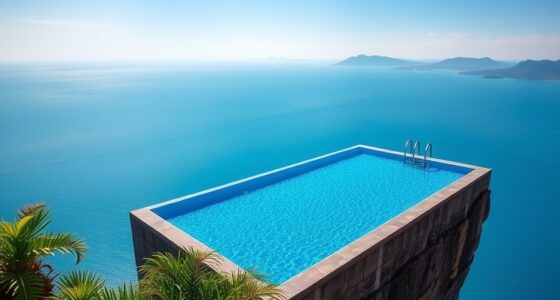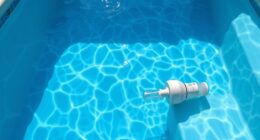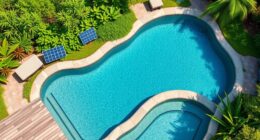To design a calm acoustic environment for your pool, focus on incorporating gentle, natural sounds like flowing water, distant waves, or soft fountain noises. Position sound sources carefully to avoid harsh echoes and guarantee the volume remains low to maintain serenity. Use water features, landscaping, and weather-resistant outdoor speakers to mask external noise and create a peaceful vibe. If you want to discover more tips on perfecting your pool’s soundscape, there’s much you can explore to enhance tranquility.
Key Takeaways
- Select gentle, low-frequency sounds like flowing water or nature recordings to promote relaxation around the pool.
- Position outdoor speakers thoughtfully to ensure even sound distribution and avoid harsh echoes or reverberations.
- Incorporate water features such as waterfalls or streams to naturally enhance the calming soundscape.
- Use sound-absorbing barriers, vegetation, or acoustic panels to mask external noise and maintain tranquility.
- Keep volume levels low and experiment with different soundscapes to create an unobtrusive, soothing poolside environment.

Creating the right soundscape for your pool can transform it into a tranquil oasis, enhancing relaxation and enjoyment. When designing this environment, understanding underwater acoustics is vital. Unlike air, sound travels faster and farther underwater, so the way sound waves behave beneath the surface markedly impacts the overall atmosphere. To craft a calming acoustic environment, you need to consider how sounds originate, move, and are absorbed in the water. Soft, gentle sounds—like the subtle hum of a fountain or the distant ripple of waves—can mask unwanted noise and create a peaceful ambiance. Recognizing the principles of underwater acoustics helps you select and position sound sources effectively, guaranteeing they produce soothing effects without overwhelming the space. Additionally, the use of appropriate sound frequency can significantly influence how calming the environment feels, as lower frequencies tend to be more soothing and less intrusive.
Transform your pool into a peaceful oasis with soothing underwater sounds and mindful acoustics.
Ambient noise control plays an essential role in establishing a serene poolside setting. Outdoor environments are inherently noisy, from traffic to wind rustling through trees, but you can manage these sounds to prevent disruption. Incorporating features such as sound-absorbing barriers, plantings, or water features designed to mask louder noises can greatly reduce ambient distractions. For instance, installing a waterfall or a gentle stream doesn’t just add visual appeal; it also helps drown out intrusive sounds from outside the pool area. Landscaping with dense foliage or acoustic panels can further absorb and diffuse noise, maintaining a quiet, restful atmosphere.
When focusing on ambient noise control, it’s important to think about the placement of sound sources. Position speakers or water features thoughtfully to optimize sound diffusion and avoid creating echo or harsh reverberations. The goal is to produce a balanced sound environment that feels natural and unobtrusive. Using sound-absorbing materials around the perimeter of your pool can also help manage external noise, preventing it from overpowering the soothing sounds you want to emphasize. This careful planning guarantees the environment remains calm and inviting, encouraging relaxation rather than distraction.
Additionally, selecting the right equipment matters. High-quality, weather-resistant speakers designed for outdoor use can produce clear, gentle sounds that enhance the overall atmosphere. You can also experiment with different soundscapes—like soft music, nature sounds, or ambient tones—to see what best suits your space. Keep in mind that the volume should be kept low enough to maintain intimacy and tranquility, avoiding any jarring or disruptive noises.
Frequently Asked Questions
How Do Soundscapes Influence Pool Safety and Swimmer Awareness?
Soundscapes notably enhance pool safety by improving underwater communication and supporting emergency alert systems. You can hear clear signals or alerts, which help swimmers stay aware of potential hazards. A well-designed acoustic environment ensures that emergency messages are easily distinguishable, reducing confusion during critical moments. By carefully managing soundscapes, you create a safer swimming experience, enabling prompt responses and better communication between lifeguards and swimmers.
What Materials Best Enhance Acoustic Comfort Around Pools?
Imagine creating a haven where every sound whispers calm instead of chaos. You’ll want to choose poolside materials like acoustic panels, soft rubber, or textured tiles that excel at sound absorption. These materials reduce echoes and noise, making the environment more comfortable. By selecting the right poolside materials, you enhance acoustic comfort, ensuring swimmers enjoy a peaceful experience and safety isn’t compromised by distracting noise.
Can Soundscapes Help Reduce Poolside Noise Complaints?
Yes, soundscapes can help reduce poolside noise complaints. By adding background music and sound masking, you create a more pleasant environment that masks loud noises from conversations or pool equipment. This technique helps to soften disruptive sounds, making the area feel calmer and more inviting. With thoughtful soundscape design, you can enhance guest experience while effectively managing noise levels, ensuring everyone enjoys the poolside atmosphere.
How Do Weather Conditions Affect Acoustic Design for Outdoor Pools?
You should consider weather conditions because humidity effects can influence sound absorption, making sounds seem more muted or echoey. Wind noise is also a big factor, as strong gusts can carry noise across the pool area, disrupting the calm environment. To minimize these issues, use windbreaks and choose materials that enhance sound absorption during humid days. Adjusting your soundscape to weather patterns helps maintain a peaceful, enjoyable poolside experience.
Are There Specific Sound Frequencies That Promote Relaxation in Pool Areas?
You’ll love the idea that low frequencies, like gentle hums around 200 Hz, can drastically boost relaxation in pool areas. These sounds, often used in sound therapy, create a soothing wave that melts stress away. Frequency modulation helps tailor these sounds, ensuring they’re perfectly calming. When you design with these frequencies, you craft an environment so tranquil, it’s as if time slows down just for you.
Conclusion
Imagine stepping into your pool area, where gentle sounds fill the air—soft water ripples, distant bird calls, and calming melodies that mask any outside noise. You might worry it’ll be distracting or overwhelming, but instead, these soundscapes create a peaceful retreat. By carefully designing your pool’s acoustic environment, you’ll find it’s easier to unwind and enjoy every moment, making your outdoor space a true sanctuary. So, embrace the calming power of sound and transform your pool into a serene escape.









